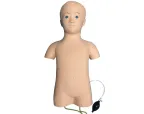Welcome to visitShanghai Chinon medical Model & Equipment Manufacturing Co., LTD
The pediatric pleural puncture training model does support repeated practice and skin replacement. This characteristic makes the model have important application value in medical education and training.

Repeated practice for support
Durable design: Children's chest piercing training models are usually made of high-quality materials, such as polymer materials or high-quality silicone rubber, which are not only highly imitations, but also have good durability. The design of the model allows repeated practice at the same piercing site without excessive wear or damage.
Seal design: The piercing site is usually self-sealing, which means that after multiple piercings, the model will retain its seal without liquid or gas leakage. This design ensures the stability and reliability of the model during repeated practice.
Ease of skin replacement
Replaceable skin design: In order to meet the needs of long-term training, pediatric thoracic puncture training models are often designed with replaceable skin. This means that during the simulation operation, if the skin part is worn or broken, it can be easily replaced with a new skin part without having to replace the entire model. This design not only reduces training costs, but also improves the sustainability of the model.
Easy replacement process: The skin replacement process is usually designed to be relatively simple and can be easily completed by a health care provider or trainer. This helps to ensure that should a skin change be needed during training, it can be done quickly and without interrupting the training flow.
Sum up
To sum up, the pediatric thoracopuncture training model not only supports repeated practice, but also has the convenience of skin replacement. These characteristics make the model an indispensable tool in medical education and training. Through repeated practice and skin replacement, medical staff can continuously improve their piercing skills and lay a solid foundation for clinical practice. At the same time, this also reflects the manufacturer's intentions and considerations in the design and production process, aiming to provide users with more practical and convenient training tools.